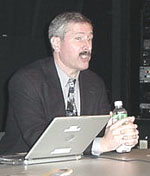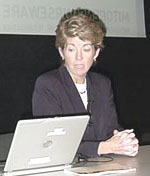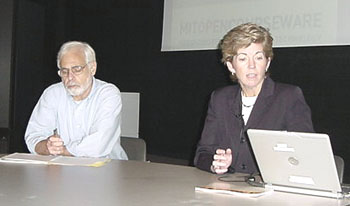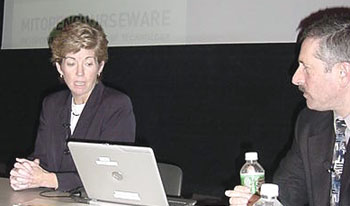| MIT OpenCourseWare: A Status Report | |||
|
Entering its third year, MIT's OpenCourseWare initiative now offers the course materials from 900 courses, from all schools and departments at the Institute. Available free of charge to anyone with access to the World Wide Web, the site is currently 35 gigabytes in size, containing 11,425 HTML pages, nearly 9,000 images and nearly 14,000 unique PDF pages. The project's ultimate goal is to make MIT's entire curriculum freely and openly available to a global audience of students, educators and self-learners. In this progress report, our speakers will discuss the challenges and false starts of this project, as well as the successes that have marked the development of this bold venture. They will demonstrate a sampling of the material available on OCW and present data profiling the global community that makes use of the site. [Tech Talk article] Speakers Anne Margulies is the executive director of the OpenCourseWare initiative. The response to OpenCourseWare is almost entirely positive, although when it was first announced, many people were nervous and asked, what is MIT really doing and what will it lead to? Most people have since become receptive to the idea. Our discussion today will focus on the vision for OCW, its implementation, its current impact and its larger context. What led to the idea of OpenCourseWare? In the fall of 1999, the midst of the dot com era, several universities were proposing for-profit Internet-based education programs. The Council on Educational Technology was formed at MIT to discuss ideas about such programs and what MIT should do about distance Internet education. Consultants hired by the committee asked faculty and the MIT community what they wished to do and what they felt would be an appropriate step to take in keeping with MIT’s core beliefs.
It was already known that a new MIT would not be created, nor would our faculty become the teachers of three million students in a virtual classroom. The faculty responded by stressing that they valued the integration of research within education, the face-to-face teacher-student interaction, and the residential education that MIT offers. After examining
a series of economic models, the Council on Educational Technology
concluded that it was not possible to run a profitable business
that respected the principles important to the faculty. Of course,
as seen with the Apollo Group, which operates the University
of Phoenix, it is possible to make a profit through distance-based
education if these MIT priorities are not relevant. This idea was just crazy enough to interest MIT faculty, and in particular, President Chuck Vest and Provost Bob Brown. Most of the faculty approved of the idea as long as it did not cost too much or take up too much time. In April of 2001, Vest publicly announced the OpenCourseWare project to The New York Times and in a press conference. He exceeded the proposed plan by publicizing the initiative as a permanent feature of the Institute. OCW became a prominent aspect of his presidency as he discussed it frequently with Corporation members and became personally involved in fundraising. The Hewlett Foundation and the Mellon Foundation agreed to provide the $11 million needed for the project’s first phase, which was launched in September 2002. This pilot program consisted of fifty hand-constructed courses, created with a great deal of work and effort. Near the end of 2002, a full-time director was hired to build regular staff, and the target of 500 courses that was promised to the foundations was met in 2003. Just last week 200 more classes were added, bringing the total to 900 courses, halfway to the long-term goal of 1,800 classes. [UPDATE: As of Nov. 1, 2005, there were 1,200 courses published on OCW.] It is important to realize what OCW is not. It is not an education, but is comparable to reading textbooks. There is no interaction, no dialogue with a professor. It is a kind of free publication available to anyone with access to the Internet. And, finally, it is permanent. OCW distributes information using technology; therefore its mission and method hold particular appeal to MIT. Faculty involvement is voluntary, so it is crucial that they benefit from this in some way. OCW helps organize materials for teaching, improves teaching by sharing best practices with a larger community, and encourages pride in the structure of curricula within each discipline. OCW also opposes the increase in privatization of knowledge. It is open to any non-commercial or educational use and can be used to teach other courses. It can also be modified and translated as long as the course’s creator is recognized and acknowledged. The goal of getting all MIT courses on line is now a realistic one, since the project has been received so positively and because we now have a developed infrastructure, set of methods, and staff. MARGULIES: OCW’s mission has become a dual mission to publish all of MIT’s course material and do this in a way that others want to emulate. It will fail in this latter mission if it only stays at MIT. While the type of material presented is variable, OCW is unique in its breadth and depth. There are courses from all 33 academic departments and the average course contains seven types of materials, adding up to over 40,000 files of content. Continuing with these statistics, 65 of the courses include video material, 75 have been translated into Spanish, and many are currently being translated into Chinese. And, seven of the courses now have learning communities that allow learners to converse with each other, asking for and offering help. The issue
of intellectual property was seen as the biggest challenge in
launching OCW. It was resolved by asking the faculty to grant
MIT and OCW the right to just digitally publish their material.
This ensured they were not giving away their rights or material.
When the first 500 courses were introduced a little over a year ago, there was significant traffic to the site, and there has been a high, steady level of traffic since. In the last year, the average number of visits per day has been about 11,000 visits. We are experiencing a spike in visits right now, which could have something to do with the introduction of the 200 new courses or the international media coverage we are receiving right now. Of these visits, 60% are international and 40% are from the U.S. India users recently topped those in China for having the most users to the site. While we regularly receive visits from users in North America, East Asia, and Western Europe, we do not have much traffic from sub-Saharan Africa, perhaps because of the lack of network infrastructure and bandwidth. To improve this, we are working on a pilot program with a university in Tanzania. We gave them a copy of the site, which they will load onto a mirror site on their fairly robust campus network. This will hopefully make OCW more available to users in sub-Saharan Africa. Who uses OCW and how do they use it? There are three groups of users: educators, students, and self-learners. Educators are using OCW to plan and develop their own courses, as well as to self-learn. Students use it to complement their own material and help them study, as well as explore other subjects that interest them. Self-learners, the largest group, use OCW to learn on their own. We asked our users to evaluate the site, and 99% said that it would have a moderate to extremely positive impact on them. Users have described in their own words the impact OCW has had on them. Sathappan Ramaswamy, an Indian self-learner wrote, “If you are able to list all the adjectives available in all the languages on Earth, it will still not explain completely a user’s feelings.” Alumni are
now also big supporters of OCW, though many were concerned when
it was first announced because they didn’t understand
it and worried that it would devalue their own degrees. One
alum, Rogerio Machado, just one of hundreds writing in support
of OCW, wrote that “as an alum from a developing country
I am proud of the beauty, lacking a truly significant word,
of this extremely generous and wise MIT initiative.” There are
now other relatively small-scale OCWs around the world in India,
Vietnam, and Germany. At least six of these sites are modeled
after the MIT site. We have partnered with a Madrid company,
Universia, to translate our courses into Spanish or Portuguese.
We have also formed a partnership with China Open Resources
for Education (CORE) in China. They are sharing 1000 of their
courses, although they have said that due to competition for
ministry resources, sharing does not come naturally to them.
Discussion: DAVID THORBURN, COMMUNICATIONS FORUM DIRECTOR: Once sites for two of my courses were launched, I immediately received e-mail requesting information on where I had gotten my materials, how I teach the class. This really shows the impact of OCW. LERMAN: For my own course, I was asked to do a video introduction, because OCW wanted to find out what instructors want to teach, how they want to teach it, and their course objectives. This video provides educational context for users, as well. I found this helpful and would like to find out if users found it helpful. MARGULIES: This sort of feedback will be part of a study that we will launch in November. We will ask for specific information, including what contents users find most helpful. THORBURN: From my own experience lecturing on OCW in Austria, I have found that the video lectures are very powerful. The audience was amazed to see the style of the lecturer and it helped them to understand the structure of the lectures. MARGULIES: About a dozen of our courses have these videotape courses and another 40 classes have video clips. These videos help give the context of how the classes are taught. QUESTION: Have you considered how you might harvest information from users for purposes besides evaluation? Users’ profile information could detail what they would like more of, what they are interested in. For example, the Sloan Review could ask users that are interested in Sloan business classes on OCW whether they would like to subscribe to the magazine. MARGULIES: We already conduct a fairly extensive survey for evaluation purposes. To acquire the sort of information you suggest it would be necessary for users to register. Many users still suspect OCW of an ulterior motive, and if we asked them to register themselves they would become confused about our motives.
THORBURN: Could you address the issue of copyright more fully? I wanted to use a cartoon from The New Yorker for one of my courses, yet couldn’t get permission to use it without paying a large fee. I was able to circumvent that particular problem because a student rendered a version of it, but this is a very prevalent problem in Humanities courses. Often, this material is central to the course. Can and will anything be done about this? MARGULIES: When we were preparing the last 200 courses, we identified about 3000 items that involved a third party. We were able to obtain permission to publish 60% of these items. Still, a lot more can be done on the issue. We have not worked with the publishers so far, and that is something we’d like to do. It may be possible to arrange a blanket agreement to allow use to use small third-party items without having to ask permission for each one. We may ask publisher to make more material available for open publishing, and in return we could provide online links back to the publisher. Instead of a revenue loss for the publisher, this partnership could turn into a marketing tool. THORBURN: There are substantial materials on OCW, such as textbooks. LERMAN: Yes, some MIT faculty authors have arranged for the book’s copyright to revert to them, so they are able to control the book if it goes out of print. This is how the site can publish these textbooks. MARGULIES: Two more textbooks will go up in the next round of publication, as well. QUESTION: What kind of organizational challenges or resistance within MIT did you face in launching the OCW project? LERMAN: In the early phases of the project, the key issue was giving the faculty of clear vision of what they were signing up for. They needed to see a model of what they were getting involved in, what we had in mind. MARGULIES: In terms of implementation, the biggest challenge was the fact that involvement was voluntary for the faculty. We listened to faculty concerns and realized that time commitment for the development process needed to be minimized as much as possible for them. We organized OCW staff into a small core group of managers and a group of department liaisons. Their task was to work with the faculty members, become familiar with the departments, encourage the faculty to take the time to look at the site and approve their course. These liaisons have really become part of the department. LERMAN: I don’t know of any other MIT organization that has this structure of a central staff and distributed staff among the departments, and we’ve learned that the faculty really likes it. QUESTION: I am familiar with a pilot program in India that has about 20 courses right now. I know that you are helping other institutions do their own pilot programs. Are they running these programs off of your software, or are they re-creating the software themselves? MARGULIES: We are aiding other pilots by giving advice on the way we handled issues such as process design or copyright concerns. It doesn’t matter to us what software they are using. We didn’t develop our own software, but used a commercial product instead. We are sharing our experience and are trying to help these pilot programs avoid pitfalls. There is also a How-To manual online that covers the entire process, the technology we used, our organization, and the benefits of OCW. It can be found at http://ocw.mit.edu/OcwWeb/HowTo/index.htm. QUESTION: I am with the Foreign Languages and Literatures department here at MIT in Chinese, and I know that Chinese is a culturally distant language. I am wondering who monitors the translations of the OCW site, since these translated sites could become a very different site. What are the consequences of this possibility? LERMAN: We cannot monitor the translations out there. With sites that we choose to recognize, we do use translators that we trust, as with Universia. What may be a larger problem is what these sites choose to translate. China blocked all of MIT’s websites for a period of time, due to political reasons. So, what these sites choose to translate may be a bigger issue. MARGULIES: No one has to ask our permission to translate the site. Universia uses professional translators to first translate the site. Then, faculty members from one of their university campuses review the materials. With our pilot program with them, our Spanish-teaching faculty approved their translations as high quality. Universia benefits from this partnership because we make the material easier to translate and they are able to have a direct link to our site. We benefit from this because Spanish and Portuguese speakers have direct access to our site. We are implementing this with China, as well. These are the only types of translations we officially recognize and link to. QUESTION: Do you know of any organization that is trying to provide this structure for K-12 mathematics and science education? MARGULIES: We have talked with some K-12 schools that are interested in this sort of program, but financial issues are a major obstacle. Also, K-12 schools are usually more reliant on textbooks, since the teaching faculty does not often write their own material. It is less likely that we will be able to publish this sort of material. LERMAN: Some self-learners are secondary students who are able to use some of our material. QUESTION: What is the cost of implementing and operating a program like OCW? MARGULIES: Most of the cost is for labor, not technology. Our software cost only about $25,000, but there is a great deal of work that goes into implementing the program and building the site. I am confident, however, that a lower-cost OCW can be developed. QUESTION: Are you using UROP (Undergraduate Research Opportunities Program) students to help develop OCW? MARGULIES: We did approach the UROP office about involving students in the project, but the office decided that the sort of work we were doing was too uncreative for students to work on as research. However, we now have some creative projects in mind for UROP students and plan to involve students more. We are paying students to take notes for a class, and once approved by the faculty, these notes are used on the site. LERMAN: Often, too, the tasks that we do are not appropriate for UROP students because they are time sensitive. Students tend to become scarce around exam periods, which is necessary and expected, so the tasks they would be asked to complete do not work with their schedules. QUESTION: Why don’t some professors download the courses from OCW and teach them, instead of developing their own material? LERMAN: Perhaps there are some that do. However, the teaching work load is so much greater at many universities, especially in developing countries, and professors may not have the time to develop lessons. I am okay with these professors using the OCW lectures and lessons, since it is practical and may be the best way to get the best material to their students. QUESTION: Why weren’t there learning communities from the beginning? MARGULIES: Cost was an issue in the beginning, and even though we realized everyone wanted something like a learning community, we had to make sure costs were contained so that MIT could permanently maintain OCW. There were also liability concerns about potential postings of embarrassing comments or materials. We are now able to provide these learning communities because we are partnered with a Utah State University faculty member who is fully funding the learning communities in order to study their methods and effectiveness. THORBURN: In the early days of the web, the MIT Communications Forum experimented with an interactive commentary and discussion. The discussion was ruined by someone who posted profanity and a stream of irrelevant comments. MARGULIES: Our learning communities have a system to deal with this problem. Users can give kudos to postings that they found especially useful or interesting, and mark disrespectful users as “flamers”. If other people agree on the flamer’s status, the user is removed from the discussion. QUESTION: What level of Internet connection is the OCW site optimized for? How are other countries’ lower Internet capacities handled? LERMAN: In sub-Saharan Africa, the price for bandwidth is extraordinarily high compared to the price here at MIT. OCW was designed to try to accommodate a range of bandwidth. MARGULIES: Most of the material on the site was designed to be accessible on a 28-K modem.
LERMAN: It is sometimes simpler to give a university a copy of OCW, which fits on a hard drive, rather than connect to the OCW site. This is what we have done with the university in Tanzania. QUESTION: It seems to me that the only way these learning communities can work is if the faculty keeps a hands-off approach toward them. Also, I am wondering how you will deal with the situation a few years from now, when all the threads in these discussions accumulate. The content will no longer be navigable to users. LERMAN: I agree that the learning communities need to be self-sustaining. It will be necessary to have various software tools that can organize this material in a semi-automated system. This will be a good area to research. QUESTION: Do the videos have closed captioning or descriptive video? How accessible to the vision and hearing impaired is the material on OCW? MARGULIES: The site is very accessible for the vision-impaired. Screen readers can read the content. We are currently working with MIT’s Computer Science and Artificial Intelligence Laboratory to develop algorithms and methods that will automatically convert video into captions. COMMENT: As a blind user, I was awed when I found the screen reader, and I have recommended OCW to other blind students. Kudos for making the site so accessible! QUESTION: Will you use evaluations of the learning communities to improve the online course sites? Also, it is hard to discuss math by just asking questions. Is there any way of dealing with this? MARGULIES: Whenever we receive mail that is specific to a course, we forward it to the faculty member. We haven’t realized the full possibilities of the learning communities yet, since they have only recently been implemented. In the future we will think about how we can use the comments we receive. LERMAN: There has been a movement toward using MathML, an XML-based standard that has the potential to allow uniform language for describing math in equations. The learning community forums are restricted to expression in characters alone. QUESTION: To what extent are interactive models, simulations, used on OCW? LERMAN: There are a fair number of interactive tools on OCW. The second semester curriculum for physics has an animation and simulation to teach electricity and magnetism. We are also thinking about having an open version of an experiment in a microelectronics class. We have built an interface that is web-accessible, so that anyone can operate the experiment from anywhere in the world. We may build a physical copy of this experiment and make an open version. This would allow students to use a semiconductor, something most students do not get to use in their undergraduate career. MARGULIES: There are about 50-100 interactive tools. The video clips are also great at capturing interaction in the classroom. QUESTION: Are there currently any special tours on the site that introduce users to features by theme? For example, a tour of the learning communities, the video courses, etc.? MARGULIES: There are not any themed tours right now, but we are working on a project to navigate the site in different ways, at a glance. LERMAN: One such approach would be to link examples of the use of a certain technique learned in a course. Users will be able to see the ways the material they are using can be applied, all in one place. There are a large number of interesting ways to look at the material on OCW, other than just a course-centric view. The future will bring further development of the OCW site. –
compiled by Marie Y. Thibault |
|||


 We
measure the response to OCW by measuring its access, use, and
impact.
We
measure the response to OCW by measuring its access, use, and
impact. 
